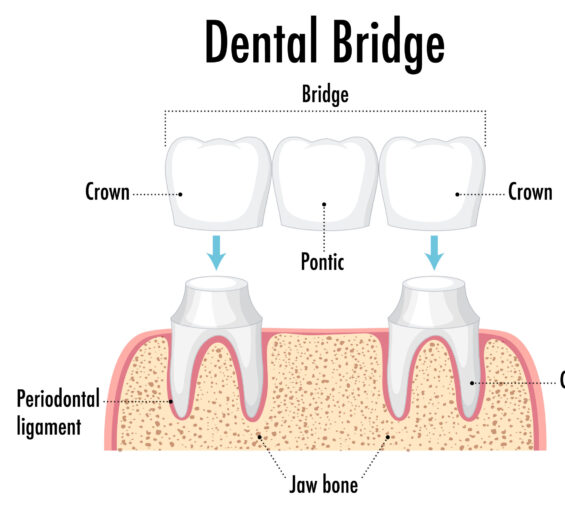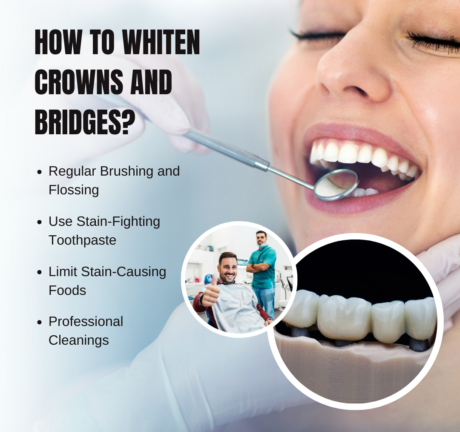Crowns and Bridges: Your Guide to a Complete Smile Again
Have you ever thought about how the notes in your smile aren't quite reaching home anymore? Perhaps a chipped tooth causes imbalances, or perhaps a space left by a missing tooth undermines your self-esteem. The good news is that it is possible to bring back your smile to its former glory with Crowns and Bridges.
Let us first familiarize you with these dental supporters before getting down to business.
What Are Crowns and Bridges?
A crown is a precisely crafted cap that replaces a tooth that is weak, broken, or cracked, giving it back its strength, functionality, and, of course, jaw-dropping appearance. Conversely, bridges are all about bridging the gaps. They fill up the gap caused by missing teeth by functioning essentially like a little bridge.
Here's the cool part: bridges aren't just standalone structures. They rely on healthy teeth on either side of the gap, which gets fitted with crowns. These crown-wearing teeth act as anchors, holding the bridge (and the replacement teeth attached to it) securely in place.
Which Area of Dentistry Specializes in Crowns & Bridges?
Just like any construction project needs a skilled engineer, crafting Crowns & Bridges is best left to a specialized dentist called a prosthodontist. These dental experts excel at restoring and replacing teeth, with specialized training in making crowns, bridges, dentures, and other dental prosthetics. To ensure you receive the best care, consulting a prosthodontist is your best bet.
Can a Dental Hygienist Do Scaling and Root Planing?
Yes, a general dentist is trained and qualified to perform scaling and root planing, which is a common Gum Disease Treatment.
While general dentists are capable of performing scaling and root planing, they may refer patients with advanced or severe cases of gum disease to a periodontist, who specializes in the treatment of gum conditions. Periodontists have advanced training and expertise in diagnosing and treating gum disease and may offer additional treatment options for more complex cases.
How Are Crowns and Bridges Made?
Your dentist will start the journey towards a perfect smile by conducting a comprehensive examination. They'll use X-rays to get a better understanding of your teeth and jawbone and might suggest preparing the nearby teeth for the crown part of the bridge. Below is a simplified explanation of how the crown and bridge are created:
Taking Impressions: Your dentist will use a special putty-like material to create a mold of your teeth. This mold acts as a blueprint for crafting the perfect-fitting crown or bridge.
Crafting the Crowns and Bridges: The dental lab receives the mold, and talented technicians there craft the crowns and bridges using the selected material. They carefully consider the color, shape, and size to guarantee a seamless and comfortable fit that looks completely natural.
Trial Run and Final Placement: Once the crowns and bridge are ready, you'll head back for a fitting. This is your opportunity to check the final placement's appearance and feel. If any changes are required, the dentist can perform them right away. Ultimately, the bridge is firmly set in place and the crowns are securely fixated onto your teeth using a small amount of anesthesia to ensure your comfort.
Crowns vs Bridges: What is the Difference Between a Crown and a Bridge?
While crowns and bridges are both restorative dental treatments, their purposes differ slightly:
Crowns: As previously said, crowns are an excellent restoration for a tooth that is in danger of breaking. When teeth are severely chipped, fractured, weakened by decay, or have had a Root Canal Treatment, they perform a remarkable job. Furthermore, crowns can be utilized cosmetically to modify the color or shape of teeth.
Bridges: The favored approach for replacing one or more missing teeth is a bridge. In addition to improving the appearance of your smile, they stop next-door teeth from moving out of alignment, which can cause chewing difficulties and biting issues.
Are Crowns and Bridges Painful to Get?
Fear of the dentist's chair is a common concern, but rest assured, getting crowns and bridges placed shouldn't be a nerve-wracking experience. Here's why:
Local Anesthetic: In order to numb the region surrounding the tooth or teeth being treated, your dentist will first use a local anesthetic. This assures that you will be pain-free when on the procedure.
Potential Post-Procedure Discomfort: After the anesthetic wears off, you might experience some mild soreness or sensitivity around the treated area. This is perfectly normal and can be easily managed with over-the-counter pain relievers.
Keeping Your Smile Sparkly White: How to Whiten Crowns and Bridges?
The materials used to make crowns and bridges usually have more stain resistance than natural teeth. But, over time, they could soak up a little amount of discoloration from tea, coffee, and other colored meals and beverages. The plus side is that it's not too difficult to keep your dental Crowns and Bridges white:
Regular Brushing and Flossing: Brushing twice a day with fluoridated toothpaste and flossing daily removes food particles and plaque that can contribute to staining.
Stain-Fighting Toothpaste: Consider using a toothpaste specifically formulated for whitening or stain removal.
Mind Your Diet: Limiting your intake of coffee, tea, red wine, and other stain-causing foods and drinks can help prevent discoloration.
Professional Cleanings: Regular dental cleanings by your dentist are crucial for removing built-up plaque and tartar that brushing and flossing alone can't reach. They can also offer additional whitening treatments for your crowns and bridges if needed.
How Long Do Bridges and Crowns Last?
You've just had your teeth cleaned, and your mouth is feeling fresh and fabulous. But then, the rumbling starts – your stomach is letting you know it's time to refuel.
The good news is, you don't have to wait too long before chowing down. In most cases, you're good to go as soon as the numbness from any anesthetic wears off (usually within an hour or two).
But there are a few things to be aware of:
- Avoid anything too hot or too cold for the first few hours, as your teeth and gums might be a bit sensitive.
- Steer clear of crunchy, hard, or sticky foods for the first 24 hours to avoid irritating your freshly cleaned teeth and gums.
- If you had any dental work done during your cleaning (like a filling or crown), your dentist might recommend waiting a bit longer before eating to allow everything to set properly.
But really, the key is to listen to your body and take it slow. Start with something soft and mild, like yogurt or scrambled eggs, and gradually work your way up to more substantial fare as your mouth starts feeling back to normal.
How Often Should You Get Your Teeth Cleaned?
With proper care, crowns and bridges can last for a good many years – we're talking anywhere from 5 to 15 years or even longer! Here are some factors that can influence their lifespan:
Type of Material Used: Bridges and crowns can be made from various materials, each with its own durability. For instance, porcelain crowns with a metal substructure tend to be stronger than all-porcelain crowns.
Your Oral Hygiene Habits: Just like your natural teeth, crowns and bridges thrive with good oral hygiene. Brushing twice a day, flossing daily, and maintaining regular dental cleanings significantly increase their longevity.
Your Diet: Chewing on hard foods or using your teeth to open things can put extra stress on crowns and bridges, potentially leading to chipping or fractures.
Underlying Dental Conditions: Certain dental conditions, like bruxism (teeth grinding), can wear down bridges and crowns faster.
The Investment in Your Smile: How Much Do Crowns and Bridges Cost?
The cost of crowns and bridges can differ based on several criteria, including:
Type of Crown or Bridge: The material used, the number of teeth involved, and the complexity of the procedure all play a role in the final cost.
Your Geographic Location: Dental fees can vary depending on where you live.
Experience of Your Dentist: Dentists with more experience might charge a little bit more.
While the exact cost can't be quoted here, it's always best to discuss pricing with your dentist during the consultation. They can provide a detailed breakdown of the fees based on your specific needs.
Does Dental Insurance Cover Crowns and Bridges?
Dental insurance plans can offer some coverage for bridges and crowns, but the specifics will depend on your individual plan. Here's a breakdown:
What Might Be Covered: Many plans cover a portion of the cost of crowns and bridges, typically categorized as a major restorative procedure.
Understanding Your Plan: It's crucial to carefully review your dental insurance plan details to understand your coverage. You'll want to know things like your annual coverage maximum and any deductibles you might have.
Talking to Your Dentist: Don't hesitate to discuss your insurance coverage with your dentist. They can help you understand what your plan covers and can work with your insurance company to pre-determine your estimated out-of-pocket costs.
Beyond Crowns and Bridges: Additional Considerations
Up until now, we have focused on crowns and bridges, but it's important to note that they might not always be the only solution for damaged or missing teeth. Here are some other options your dentist might discuss:
Dental Implants: Dental implants may be a possibility if you're searching for a more long-term and aesthetically pleasing option for replacing missing teeth. Implants are titanium posts inserted surgically that serve as bridge or crown anchors.
Dentures: Removable dentures can be used to replace all of the teeth in your upper, lower, or both jaws. Even though they provide an affordable option for replacing several missing teeth, they might not be appropriate for everyone.
Ultimately, the best course of treatment for you will depend on your specific situation and dental health.
A Complete Smile Starts Here: Elite Smile Family Dentistry in Northville, MI
If you're considering restoring your smile's health and beauty, then you’re at the right place.
At Elite Smile Family Dentistry, our skilled and caring dentists are committed to delivering exceptional dental care in a warm and inviting atmosphere. We provide thorough consultations to address your individual requirements and suggest the best treatment choices, such as crowns and bridges, dental implants, and dentures. Moreover, our amiable team is always ready to assist you with insurance matters and make sure you maximize your benefits.
Schedule an appointment with Elite Smile Family Dentistry today and take the first step towards a complete and confident smile! We are eager to assist you in attaining your dental objectives.
Conclusion
You got it! This detailed guide has given you the information necessary to grasp crowns and bridges. Whether you have a chipped tooth or a missing one, these dental aids can bring back both the function and beauty of your smile.
Visit Elite Smile Family Dentistry in Northville, MI where we're dedicated to making your dental dreams a reality. Get in touch now to book a consultation and let our skilled team lead you to a healthy, happy smile!



